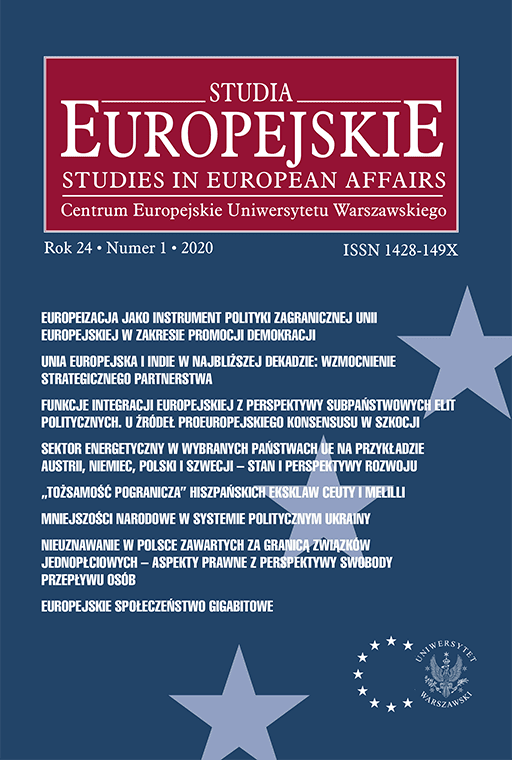
ISSUE: 1/2020
- Volume 24
- Number 1
- 2020
Subscribe NEWSLETTER
Studia Europejskie –
Studies in European Affairs
ISSN: 1428-149X
e-ISSN: 2719-3780
License
Articles published in the journal are under a Creative Commons Attribution – Non Commercial – No Derivatives 4.0 International License
Sektor energetyczny w wybranych państwach UE na przykładzie Austrii, Niemiec, Polski i Szwecji – stan i perspektywy rozwoju
The Energy Sector in Selected EU Member States on the Example of Austria, Germany, Poland and Sweden – Current Status and Development Perspectives
Abstract
The European Union undertakes numerous activities to implement a common energy policy for all Member States. However, since the countries in question have different energy resources, geographical location and terrain, unification of national policies at EU level is a particularly arduous and difficult process. This article focuses on the analysis of energy sectors in Austria, Germany, Poland and Sweden. These countries were chosen because they offer considerable diversity, having different energy resources, geographical location, climatic conditions, as well as a different genesis of shaping their energy policy over the years. The analysis showed that the energy sectors in Poland, Germany, Austria and Sweden operate completely differently and rely on different energy resources. In Sweden, electricity mainly comes from hydropower and nuclear energy, while energy from coal is not produced at all. In Austria, coal is also not extracted, and the production of electricity is based mainly on renewable sources, and above all on hydropower. Germany is one of the countries with the highest level of coal mining in the world, therefore electricity is obtained mainly from this source, but also from nuclear energy and increasingly from renewable sources, mainly wind, biofuel and solar energy. Poland is among the world’s leading producers of coal, and obtaining electricity from this source accounts for as much as 80% in Poland; the rest comes from renewable sources, mainly wind energy, then biofuels, hydro energy and natural gas.
References
Coal in Europe 2008, Coal in Europe 2018, https://euracoal.eu/info/euracoal-eu-statistics/ (dostęp 28.12.2019).
Coal industry across Europe, 6th edition with insights 2017, https://euracoal.eu/library/publications/ (dostęp 4.01.2020).
Coal phase out in the European Union, http://climateanalytics.org/briefi ngs/ eu-coal-phase-out.html (dostęp 15.12.2019).
Complete Energy balances, https://appsso.eurostat.ec.europa.eu/nui/submitViewTableAction.do (dostęp 12.01.2019).
Draft Integrated National Energy and Climate Plan for Austria 2021–2030, Vienna, December 2018, https://ec.europa.eu/energy/sites/ener/files/documents/ec_courtesy_translation_at_necp.pdf (dostęp 3.01.2020).
Draft of National Energy and Climate Plan for the years 2021–2030. Objectives and targets, and policies and measures, Draft – v. 3.1 of 4 January 2019, https://ec.europa.eu/energy/sites/ener/files/documents/poland_draftnecp_en.pdf (dostęp 3.01.2020).
Electricity and heat statistics, https://ec.europa.eu/eurostat/statisticsexplained/ index.php?title=Electricity_and_heat_statistics&oldid=443526# Derived_heat_production (dostęp 21.12.2019).
Electricity price statisctics, https://ec.europa.eu/eurostat/statisticsexplained/ index.php/Electricity_price_statistics#Electricity_prices_for_household_consumers (dostęp 21.12.2019).
Energia 2019, Warszawa 2019.
Energy dependency rate, http://ec.europa.eu/eurostat/statistics-explained/index.php?title=Glossary:Energy_dependency_rate (dostęp 27.12.2019).
Energy import dependency by products (% of imports in total Energy consumption), https://ec.europa.eu/eurostat/databrowser/view/sdg_07_50/default/table?lang=en (dostęp 19.12.2019).
Germany’s Draft Integrated National Energy and Climate Plan, https://ec.europa.eu/energy/sites/ener/files/documents/ger_draft_necp_eng. pdf (dostęp 28.12.2019).
Global Energy Statistical Yearbook 2019, https://yearbook.enerdata.net/coal -lignite/coal-world-consumption-data.html (dostęp 23.12.2019).
Government Offices of Sweden, Ministry of the Environment and Energy, Sweden’s draft integrated national Energy and climate plan, https://ec.europa.eu/energy/sites/ener/files/documents/sweden_draftnecp.pdf (dostęp 3.01.2020).
Górka K., Opłacalność wykorzystania i rozwój odnawialnych źródeł energii w Polsce, „Zeszyty naukowe Akademii Ekonomicznej w Krakowie” nr 668/2005. Hydropower key facts 2018, https://www.hydropower.org/keyfacts2018 (dostęp 15.12.2019).
Import i eksport węgla kamiennego w Polsce, https://www.pgi.gov.pl/psg-1/ psg-2/informacja-i-szkolenia/wiadomosci-surowcowe/10419-import-ieksport-wegla-kaminnego-w-polsce.html (dostęp 21.12.2019).
Młynarski T., Tarnawski M., Źródła energii i ich znaczenie dla bezpieczeństwa energetycznego w XXI wieku, Wydawnictwo Difin SA, Warszawa 2016.
Overview: National coal pase-out announcements in Europe, status March 2019, https://beyond-coal.eu/wp-content/uploads/2019/02/Overview -of-national-coal-phase-out-announcements-Europe-Beyond-CoalMarch-2019.pdf (dostęp 27.12.2019).
REN21, Renewables 2019. Global status report, (Paris: REN21 Secretariat) 2019.
Renewable energy statistics, http://ec.europa.eu/eurostat/statisticsexplained/index.php/Renewable_energy_statistics#Renewable_energy_ produced_in_the_EU_increased_by_two_thirds_in_2006-2016 (dostęp 19.12.2019).
Renewable Power Generation. Costs in 2017, Interantional Renewable Energy Agency, Abu Dhabi 2018. Share of Energy from renewable sources in gross fi nal consumption of Energy 2004–2017, https://ec.europa.eu/eurostat/statistics-explained/images/4/4d/Share_of_energy_from_renewable_sources_in_gross_final_consumption_of_energy%2C_2004-2017_%28%25%29.png (dostęp 20.12.2019).
Słownik Wyrazów Obcych, PWN, Warszawa 1980.
The European Power Sector in 2018. Up to date analysis on the electricity transition, January 2019.
DOI: 10.33067/SE.1.2020.4
Language: Polish
Pages: 67-82
How to Cite:
Harvard
Latoszek, E. and Wójtowicz, A. (2020) "Sektor energetyczny w wybranych państwach UE na przykładzie Austrii, Niemiec, Polski i Szwecji – stan i perspektywy rozwoju". Studia Europejskie – Studies in European Affairs, 1/2020, pp. 67-82. DOI: 10.33067/SE.1.2020.4